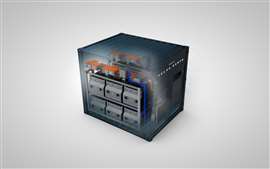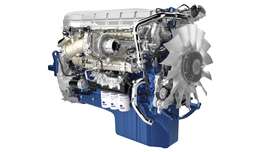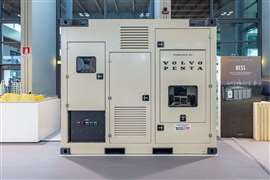Volvo Penta shows new power solutions
22 March 2024
PowerGen International 2024 saw Volvo Penta highlight two key products: its new 17-liter D17 generator set engine and its recently announced battery energy storage subsystem (BESS) technology.
 The 17-liter D17 delivers an optimized power-to-weight ratio within the same footprint as the 16-liter D16. (Photo: KHL Staff)
The 17-liter D17 delivers an optimized power-to-weight ratio within the same footprint as the 16-liter D16. (Photo: KHL Staff)
With the addition of the 705-kWe D17, Volvo Penta has grown its power node offering to cover from 200 up to 700 kW. The compact, inline six-cylinder engine incorporates a slightly larger engine block that allows for the added displacement, said Darren Tasker, vice president of Industrial Sales, Volvo Penta. A modernized fuel injection system with a common rail design is engineered for fuel efficiency. Dual-stage turbochargers and heavy-duty steel pistons provide a dense power set up.
The engine delivers an optimized power-to-weight ratio within the same footprint as the D16. “This was a joint development between the Volvo Group companies,” Tasker said. As such, it was important to maintain the mounting positions for the engine, cooling connections, turbo position, air filters, etc. “We kept that all the same as the 16 L… so from an installation perspective, our customers will see no change.
“It’s a cost-effective, simple way of getting to that higher power node without a significant engineering investment,” he added.
Power generation as first step
The dual-speed (1,500/1,800 rpm) engine is suited for a variety of applications but will be initially targeted to standby and prime power gen-sets.
“We’re going to start by selling this into the power generation market,” Tasker said. “The second step would be to develop a variable-speed version of the engine so we can sell it into the off-highway markets.”
The company noted it is also exploring alternative fuel options for the D17, including the development of a natural gas version.
The D17 is compliant with UNECE REG 96 Stage 2 and it is certified for U.S. EPA Tier 2 Stationary Emergency, enabling it to be used for supplying a few hours of backup power in highly regulated regions. Like all Volvo Penta gen-set engines, the new model complies with the ISO 8528 G3 standard for load acceptance.
The case for BESS
 Volvo Penta’s BESS subsystem is comprised in part of energy-dense battery systems with optimized C-rates tailored for industrial use. (Photo: Volvo Penta)
Volvo Penta’s BESS subsystem is comprised in part of energy-dense battery systems with optimized C-rates tailored for industrial use. (Photo: Volvo Penta)
Early in 2023, Volvo Penta announced plans to expand into subsystems for manufacturers of battery energy storage systems (BESS).
The battery systems utilized in the subsystems originate from Volvo Group’s electrification platform. They’re used in heavy-duty applications such as electrified trucks, buses and construction equipment, which require compact, energy dense solutions.
“We’re taking components from the Volvo Group and we’re adding expertise from Volvo Penta to turn it into a subsystem that our customers can take from us and integrate it into the finished product,” Tasker stated.
The modular and scalable subsystem incorporates a high-energy-density and high-power battery system with optimized C-rating designed to allow for fast charging and rapid discharge. “It’s an extremely energy dense battery [that is] liquid cooled so we can get even more energy in there,” said Tasker.
According to Volvo Penta, the technology would benefit BESS OEMs in segments where energy density is a priority, such as peak shaving, energy arbitrage, EV charging and temporary power demand.
The subsystem is purpose-built and designed to be scalable up to hundreds of megawatt hours. “The subsystem that we can build is very flexible,” said Tasker. “The customers we’re working with are putting, say, six or 12 of them into a customized container and then you can parallel as many of these containers together as needed.”
The complete subsystem includes the energy-dense battery packs plus a thermal management system, high-voltage cabling and power distribution and is packaged in a safe, easy to integrate way, Volvo Penta added.
Complimentary products
Tasker said the BESS subsystems can work hand-in-hand with the company’s diesel products.
“The [power grid] is moving into more distributed energy than centralized power stations,” he noted. Distributed power generation can specify a certain amount of backup power in the form of energy storage. But that power can be quickly depleted during prolonged outages. “If the outage stays longer than an hour or two, or whatever the energy storage is sized for, then you move over to the more conventional diesel. But it means you can downsize the diesel.
“If we can use diesel and/or renewables to recharge the batteries, we can blend in different technologies to lower the carbon footprint,” he added – something that is increasingly important for many customers.
“So, we very much see the energy storage and the diesel product as complimentary,” he concluded.
The company added that improved engine brake power across the entire speed range allows for fast gearshifts and more efficiency going downhill.
 Volvo Trucks’ D17 Euro 6 engine. (Photo: Volvo Trucks)
Volvo Trucks’ D17 Euro 6 engine. (Photo: Volvo Trucks)
Volvo FH16 truck gets 17L engine
Volvo Trucks also introduced the D17 as a new Euro 6 engine for its FH16 truck. The 17L engine is certified to run on biofuels and comes in power ratings of 600, 700 and 780 hp. Torque levels have been increased to 3,000, 3,400 and 3,800 Nm.
Volvo Penta said the higher power and torque levels translate into faster engine response, better driveability, maximum productivity and improved fuel efficiency.
“When climbing steep grades on a road with maximum loads, you don’t want to get stuck with too little torque and power. That is why we have focused all our efforts on making the D17 engine very powerful, reliable and responsive. For our customers, this translates into getting the job done faster with improved fuel efficiency,” said Marcos Weingaertner, product manager at Volvo Trucks.
The D17 has a single turbocharger designed to boost engine responsiveness and improve the driving experience. The wave piston design optimizes combustion and reduces emissions, while the new injection system optimizes fuel economy, said Volvo Trucks. Increased peak cylinder pressure enables high power output.
|
STAY CONNECTED



Receive the information you need when you need it through our world-leading magazines, newsletters and daily briefings.
CONNECT WITH THE TEAM









